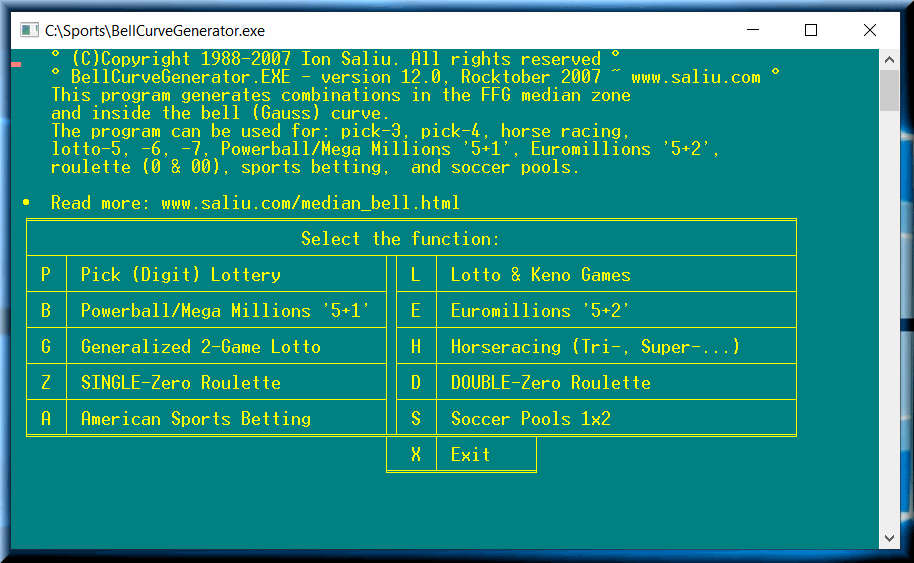
BELLBET – Generate Combinations inside the Bell (Gauss) Curve, Around the Median
By Ion Saliu,
Founder of Probability Theory of Life



Posted on February 15, 2001.
• As you know, the median plays an important role in random events. You also know that the winning chance is lower in the first trials. Let's say I generate a random pick-3 lottery combination. I don't have a high expectation I'll get the winning combination in my first trial. The chance increases with the number of combinations generated UP TO a limit. That limit is the MEDIAN, as calculated by FFG. After the median, the chance decreases at the same pace it increased. A few users of my lottery software experienced what I just presented. Said Don in his post: "Can anyone point me to more details on the lottery filters?":
"It DID PICK THE WINNER, but it was near the middle of the run of about 9,000 lotto numbers!"
BELLBET generates 10 combinations in the median zone. It handles: sports betting, roulette, pick-3, pick-4 lotteries, and horse racing.
Here is a sample of a pick-4 output file:
The median of the pick-4 game is 6931. This is one way to look at the median: In order to get 5000 unique pick-4 numbers, we need to generate 6931 combinations. Or, as presented elsewhere on this site, half of the pick-4 numbers repeat after less than 6931 drawings. The other half repeat after more than 6931 drawings.
Of course, I don't advocate here getting drunk with illusions. The expectation is higher that the winning combinations will fall within the 10 around the median. But nobody should expect to get the winners all the time, or very often. Again, the chance is better.
The program is so much faster than any other combination generator. It is the result of generating combinations in memory only. Printing the combinations even to screen slows down the execution. If you try a sports betting example -- 15 games, 3 outcomes --, there is a total of some 14 million combinations. The median is close to 10 million. It takes BELLBET some 5 minutes to reach the median zone (10 million). It would take other generators several hours to reach the same point.
I may write another program to cover the lotto games. There are some issues. First, there are many formats, medians, and a huge number of combinations. I need some input from more LotWon users, something in Don's manner. But I need more details: the game format, what filters you used, their values, how many combinations generated, the line numbers where you spotted winners, etc. I might try first with lotto wheels. Or maybe I'll upgrade the combination generator used on this message board. DOS, however, beats Windows hands down in lottery speed.
6926: 6 4 3 2
6927: 7 5 6 3
6928: 5 0 0 4
6929: 3 2 9 5
6930: 2 0 9 5
6931: 4 1 0 3
6932: 9 6 5 5
6933: 3 8 5 1
6934: 0 4 1 1
6935: 0 6 4 1

BellCurveGenerator is now the best software to generate combinations and sets under the FFG bell curve.

• LexicographicSets , the universal permutations, arrangements and combinations lexicographic indexing (ranking);
• PermuteCombine, the universal permutations, arrangements and combinations generator for any numbers and words;
• Combinations, the universal combinations generator for any lotto, Keno, Powerball game: N numbers taken M at a time, in K steps;
• NthIndex ~ lexicographic indexing superseded by LexicographicSets;
• SEQUENCE ~ lexicographic indexing superseded by LexicographicSets;
• COLORDER - lexicographical indexing for lotto and Powerball only;
• DrawIndex - highly automated lexicographical indexing for lotto draw files.
Resources in Theory of Probability, Mathematics, Statistics, Standard Deviation, Software
See a comprehensive directory of the pages and materials on the subject of theory of probability, mathematics, statistics, standard deviation, plus software.

